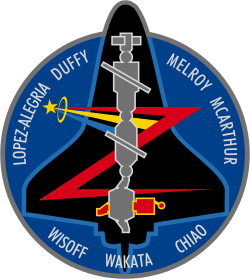Pamela Melroyová
| Pamela Anne Melroyová | |
|---|---|
 | |
| Astronautka NASA | |
| Státní příslušnost | Spojené státy americké |
| Datum narození | 17. září 1961 (61 let) |
| Místo narození | Palo Alto, Kalifornie, USA |
| Hodnost | důstojnice |
| Čas ve vesmíru | 38 dní 20 hodin 4 minuty |
| Kosmonaut od | 8. prosince 1994 |
| Mise | STS-92, STS-112, STS-120 |
| Znaky misí | |
| Některá data mohou pocházet z datové položky. | |
Pamela Anne Melroyová (* 17. září 1961 Palo Alto, Kalifornie, Spojené státy americké) – důstojnice United States Air Force a astronautka NASA. Jako pilot raketoplánu se zúčastnila misí STS-92 a STS-112, při misi STS-120 byla velitelkou letu.
Vzdělání, vojenská kariéra
Melroyová získala v roce 1983 titul bakaláře fyziky a astronomie na Wellesley College. V roce 1984 pak ukončila magisterské studium v oboru Země a planetární vědy na Massachusettském technologickém institutu. 18. května 2008 získala čestný titul (honorary degree) na Iona College v New Rochelle, New York.
Nastoupila do armády, stala se pilotkou. V průběhu Války v Zálivu v roce 1991 se zúčastňovala bojových letů. Působila na Edwardsově letecké základně jako testovací pilotka. Z armády odešla v roce 2007.
Lety do vesmíru
Melroyová byla v roce 1994 vybrána jako kandidátka na astronautku a prodělala výcvik pro pilotování raketoplánu. Pilotovala raketoplán při dvou misích, obě mise byly návštěvami Mezinárodní vesmírné stanice: STS-92 v roce 2000 a STS-112 v roce 2002. 19. června 2006 NASA oznámila, že Melroyová bude velet raketoplánu při misi STS-120. Stala se tak druhou ženou, která velela raketoplánu (po Eileen Collinsové).[1] Posádka mise STS-120 navštívila stanici v době, kdy zde pracovala Expedice 16, které velela Peggy Whitsonová. Na palubě ISS byly tedy současně dvě ženy – velitelky.[2][3]
- STS-92, Discovery (11. října 2000 – 24. října 2000)
- STS-112, Atlantis (7. října 2002 – 18. října 2002)
- STS-120, Discovery (23. října 2007 – 7. listopadu 2007)
Odkazy
Reference
V tomto článku byl použit překlad textu z článku Pamela Melroy na anglické Wikipedii.
- ↑ MALIK, Tariq. NASA Names Second Female Shuttle Commander [online]. Space.com, 2006-6-19 [cit. 2008-09-12]. Dostupné online. (anglicky)
- ↑ NASA Biography of Melroy
- ↑ Spacefacts biography of Pamela Melroy
Externí odkazy
 Obrázky, zvuky či videa k tématu Pamela Melroyová na Wikimedia Commons
Obrázky, zvuky či videa k tématu Pamela Melroyová na Wikimedia Commons - (česky) Melroyová v encyklopedii MEK
- (česky) Melroyová v encyklopedii SPACE 40
Média použitá na této stránce
Designed by the crew members, the STS-92 patch symbolizes the second mission to carry U.S.-built elements to the International Space Station (ISS) for assembly. The black silhouette of the Space Shuttle Discovery stands out against the deep blue background of space in low Earth orbit. In the foreground in gray is a profile view of the ISS as it appears when the shuttle and crew arrive, with the station consisting of the Unity node, its two pressurized mating adapters (PMA), the Zarya functional cargo block, the Zvezda service module, and the Progress cargo vehicle.
Following the shuttle's rendezvous and docking, the ISS configuration will be augmented by the two elements delivered by Discovery–the Z1 truss and PMA-3. These two elements, depicted in red, will be installed using the shuttle's robot arm and be connected to ISS during four spacewalks. The multi-national nature of both the STS-92 crew and the ISS are reflected in the multi-colored Astronaut Office symbol.
The STS-112 emblem symbolizes the ninth assembly mission (9A) to the International Space Station (ISS), a flight which is designed to deliver the Starboard 1 (S1) truss segment. The 30,000 pound truss segment will be lifted to orbit in the payload bay of the Space Shuttle Atlantis and installed using the ISS robotic arm. Three space walks will then be carried out to complete connections between the truss and ISS. Future missions will extend the truss structure to a span of over 350 feet so that it can support the solar arrays and radiators which provide the electrical power and cooling for ISS. The STS-112 emblem depicts ISS from the viewpoint of a departing shuttle, with the installed S1 truss segment outlined in red. A gold trail represents a portion of the Shuttle rendezvous trajectory. Where the trajectory meets ISS, a nine-pointed star represents the combined on-orbit team of six shuttle and three ISS crew members who together will complete the S1 truss installation. The trajectory continues beyond the ISS, ending in a six-pointed star representing the Atlantis and the STS-112 crew.
STS120-S-001 (February 2007) --- The STS-120 patch reflects the role of the mission in the future of the space program. The shuttle payload bay carries Node 2, the doorway to the future international laboratory elements on the International Space Station. On the left the star represents the International Space Station; the red colored points represent the current location of the P6 solar array, furled and awaiting relocation when the crew arrives. During the mission, the crew will move P6 to its final home at the end of the port truss. The gold points represent the P6 solar array in its new location, unfurled and producing power for science and life support. On the right, the moon and Mars can be seen representing the future of NASA. The constellation Orion rises in the background, symbolizing NASA's new exploration vehicle. Through all, the shuttle rises up and away, leading the way to the future. The NASA insignia design for Shuttle flights is reserved for use by the astronauts and for other official use as the NASA Administrator may authorize. Public availability has been approved only in the form of illustrations by the various news media. When and if there is any change in this policy, which is not anticipated, it will be publicly announced.



